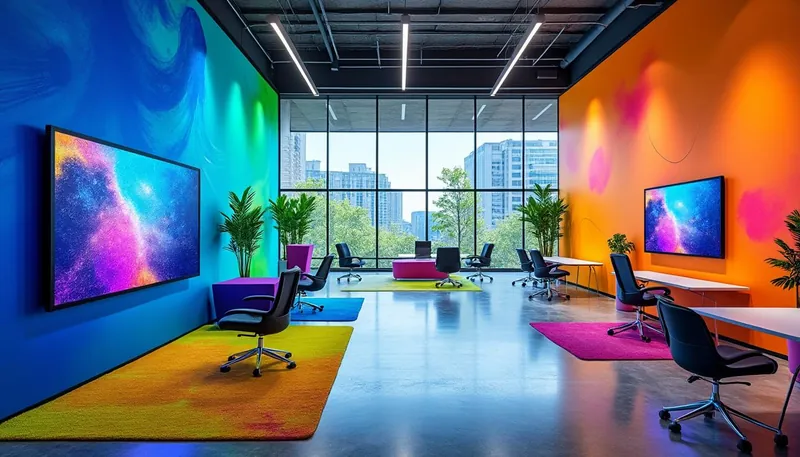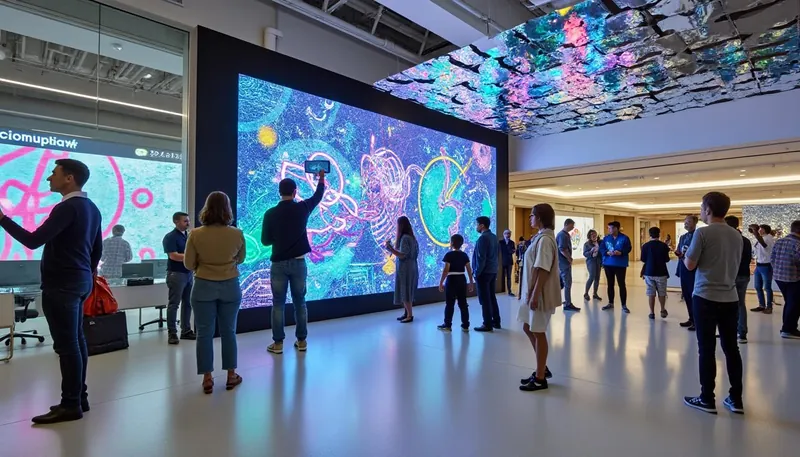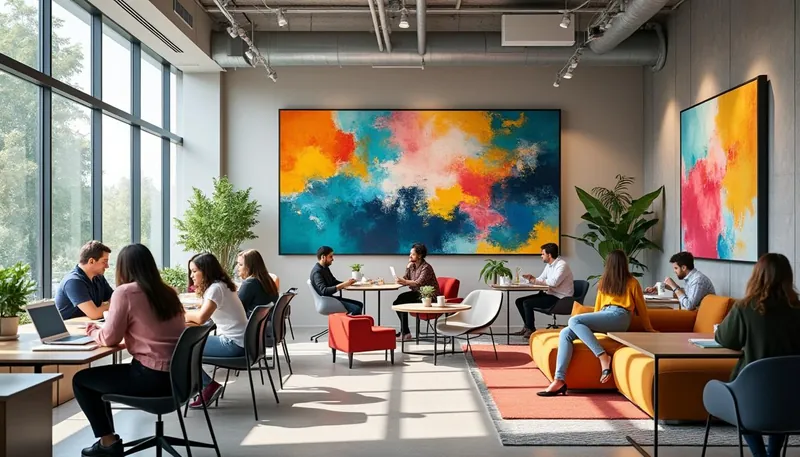In today’s fast-paced corporate landscape, the ambience of an office space plays a pivotal role in shaping employee experiences and productivity. Artwork, often overlooked, can significantly influence the dynamic within workplace environments. From boosting morale to fostering creativity, art serves multi-faceted purposes that extend beyond mere decoration. Implementing artistic elements into workplace design reflects an organization’s values and cultivates a culture of innovation and collaboration. This article delves into the various impacts of artwork in workplace design and explores tangible strategies for integrating art into office spaces.
Brief:
- 🎨 Art as a morale booster: Energizes and motivates employees.
- 🧑🎨 Reflection of company values: Communicates a brand’s identity effectively.
- 📈 Enhances productivity: Visually stimulating environments can lead to improved performance.
- ☀️ Stress reduction: Creates a calming atmosphere for better well-being.
- 🤝 Fosters collaboration: Art encourages interaction among team members.
The Role of Art in Shaping Workplace Culture
Art does more than beautify office space—it shapes the very culture within that environment. When carefully selected and positioned, artwork can communicate the essence of an organization. For instance, a tech company might display abstract pieces that evoke innovation and forward-thinking, while a community-focused non-profit might opt for local artists’ works that tell impactful stories. This curatorial choice illustrates the company’s commitment to supporting local culture and inclusivity.
Creating Emotional Resonance
Artwork can significantly affect the emotional landscape of a workplace. Research indicates that environments rich in artistic expression can enhance psychological safety, making employees feel welcomed and valued. For example, a well-placed installation may foster curiosity, prompting genuine conversations among employees, thus breaking down hierarchical barriers. Moreover, small pieces of artwork in individual workspaces can individualize the experience, allowing employees to express their personality and feel a sense of ownership.
- 😍 Promotes positivity: Bright, colorful pieces can evoke joy and energetic vibes.
- 🤔 Encourages mindfulness: Calming visuals can lead to better focus and reduced anxiety.
- 💪 Supports teamwork: Collaborative art projects can create bonds among colleagues.

Art’s Practical Benefits
Companies that incorporate art into their design strategy not only look appealing but also reap practical benefits. Statistics show that organizations prioritizing workplace aesthetics experience reduced turnover rates and improved employee satisfaction. Art can motivate employees to perform at their best and demonstrate an organization’s investment in their well-being, creating loyalty.
| Benefits of Art in Workplace | Impact |
|---|---|
| Boosts employee morale | Heightened satisfaction and engagement |
| Encourages creativity | Innovative ideas and enhanced problem-solving |
| Reinforces brand identity | Cohesive message about organizational values |
| Reduces stress | Improved mental health and workplace atmosphere |
| Attracts talent | Competitive advantage in hiring |
Strategies for Crafting Artful Spaces
To harness the benefits of art in a workplace, organizations can take practical steps. Here are some effective strategies for creating ArtfulSpaces:
Curating a Diverse Art Collection
A robust art collection can create a unique identity for a workspace. Businesses should consider the following:
- 🖼️ Support local artists: This not only promotes community but brings fresh, unique narratives into the office.
- 🌈 Variety of mediums: Incorporating different forms of art—paintings, sculptures, digital displays—can offer diverse experiences.
- 🔄 Rotating exhibits: Changing artwork periodically keeps the workspace engaging and dynamic.
Aligning Art with Brand Identity
Each artwork must resonate with the essence of the brand. Art can visually articulate the company’s ethos and goals. Here are a few key tactics:
- 📚 Thematic consistency: Choose pieces that echo the company’s industry or mission.
- 💡 Color schemes: Align art colors to match the company’s branding, ensuring a cohesive look.
- 🔤 Inspirational messages: Quotes or mission statements incorporated into artwork can strengthen team motivation.

The Creative Process of Integrating Art
Integrating art into workplace design involves a thoughtful approach. Employee participation can enrich the process, transforming the office into a canvas for collaboration.
Encouraging Employee Participation
Inclusive efforts yield a sense of community and belonging. Consider these methods:
- 🎨 Employee participation: Allow staff to contribute artwork or feedback on selections.
- 🖌️ Collaborative projects: Facilitate communal art pieces where everyone can contribute.
- 📸 Interactive installations: Create spaces where employees can express themselves creatively, such as writable walls.
Functional and Aesthetic Elements
Combining functionality with aesthetics can enhance the appeal of the workplace. Key aspects include:
- 🪑 Designer furniture: Invest in unique and visually striking pieces that align with the overall art theme.
- 💡 Architectural features: Utilize design elements like open spaces and textured walls to create visual interest.
| Office Areas | Suggested Art Integration |
|---|---|
| Reception and Lobby | Bold statement art that creates a memorable first impression |
| Workstations | Personal art selections tailored to foster focus and creativity |
| Meeting Rooms | Abstract art to stimulate dialogue and innovative thinking |
| Break Rooms | Vibrant, uplifting artworks to encourage relaxation and social interaction |
Final Thoughts on Art’s Impact and Practical Considerations
The intersection of creativity and workplace design leads to enhanced employee experiences and enriches overall company culture. Organizations must also consider practical aspects while embarking on their artistic journey.
Budgeting for Art in the Workplace
Budgeting rightly can determine the success of implementing art. Here are some considerations:
- 💰 Art leasing: Consider leasing options for a rotating collection without a hefty upfront investment.
- 🖨️ Reproductions: High-quality prints can offer budget-friendly alternatives to original works.
Consulting Professionals
Working with art consultants and designers can ensure a cohesive and appealing integration. Suggestions include:
- 🎨 Art consultants: Collaborate with experts to select fitting pieces that communicate brand values.
- 🏢 Interior designers: Engage designers to create spaces that blend functionality and art seamlessly.
Gathering Employee Input
Involving employees in the decision-making plays a vital role in the success of the art integration process. Key considerations include:
- 📝 Surveys and feedback: Gather input to ensure the artwork resonates with staff.
- 👥 Art committees: Form groups responsible for art selection and management.
How does art improve employee productivity?
Art improves productivity by creating visually stimulating environments that inspire creativity and reduce stress levels.
What types of art are best for workplaces?
A variety of art forms including paintings, sculptures, and interactive installations can be effective, depending on the workplace culture and brand identity.
Are there costs associated with integrating art in my workplace?
Yes, costs vary based on artwork selection; leasing and reproductions can provide cost-effective options.
Can employee participation influence art selection?
Absolutely! Involving employees can enhance their connection to the artwork, fostering a sense of community.


